
Nudibranchs are a group of soft-bodied marine gastropod molluscs which shed their shells after their larval stage. They are noted for their often extraordinary colours and striking forms, and they have been given colourful nicknames to match, such as "clown", "marigold", "splendid", "dancer", "dragon", or "sea rabbit". Currently, about 3,000 valid species of nudibranchs are known.
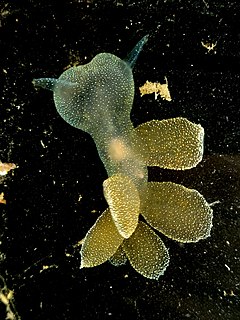
Melibe leonina, commonly referred to as the hooded nudibranch, lion nudibranch, or lion's mane nudibranch, is a species of predatory nudibranch in the family Tethydidae.

Nembrotha lineolata is a species of nudibranch, a sea slug, a marine gastropod mollusk in the family Polyceridae. It is found in shallow water in the Indo-Pacific. It was first described in 1905 by the Danish malacologist Rudolph Bergh. The type locality is Selayar Island, Indonesia.
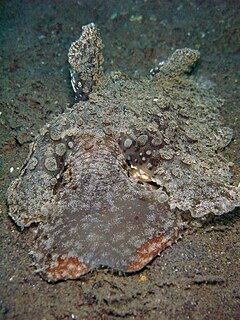
Melibe viridis is a species of sea slug, a nudibranch, a marine gastropod mollusk in the family Tethydidae.

Melibe is a genus of sea slugs, nudibranchs, marine gastropod mollusks in the family Tethydidae.

Bornella is a genus of sea slugs, specifically dendronotid nudibranchs in the family Bornellidae.
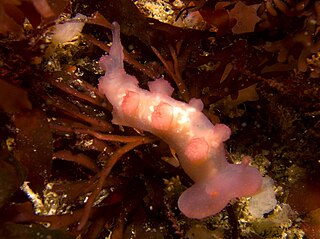
Melibe rosea, the cowled nudibranch, is a species of sea slug, a dendronotid nudibranch, a marine gastropod mollusc in the family Tethydidae.
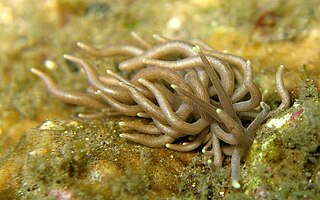
Phyllodesmium is a genus of predatory sea slugs, aeolid nudibranchs, marine gastropod molluscs in the family Facelinidae.

Tambja is a genus of colorful sea slugs, dorid nudibranchs, shell-less marine gastropod mollusks in the family Polyceridae.

Hypselodoris regina is a conspicuous species of sea slug or dorid nudibranch, a marine gastropod mollusk in the family Chromodorididae.

Berghia is a genus of sea slugs, aeolid nudibranchs. They are shell-less marine gastropod molluscs in the family Aeolidiidae. They are covered in cerata which give them their unique tentacle look and color. Berghia are commonly found in shallow waters and their diet consists of strictly Aiptasia Anemone. This genus is now commonly used commercially to fight off Anemone populations in fish tanks.
Anteaeolidiella saldanhensis, is a species of sea slug, an aeolid nudibranch. It is a shell-less marine gastropod mollusc in the family Aeolidiidae.
Anteaeolidiella poshitra is a species of sea slugs, an aeolid nudibranch. It is a marine gastropod mollusc in the family Aeolidiidae.
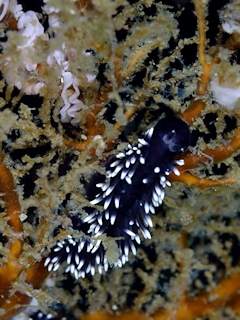
Protaeolidiella atra is a species of sea slug, an aeolid nudibranch, a marine gastropod mollusc in the family Pleurolidiidae.
Hermosita is a genus of sea slugs, specifically of aeolid nudibranchs. Only two species are known to belong to this genus, marine gastropod molluscs in the family Facelinidae.
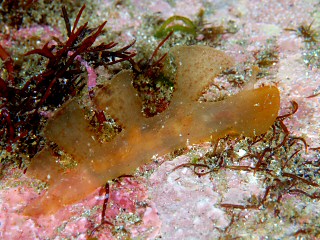
Melibe papillosa is a species of sea slug, a nudibranch, a marine gastropod mollusk in the family Tethydidae. This species is yellowish and somewhat translucent. The oral hood, which is large, has flattened hatchet-shaped cerata. It is found in the waters around Japan.

Aeolidia filomenae is a species of sea slugs, an aeolid nudibranch, a marine gastropod mollusc in the family Aeolidiidae. Previously confused with Aeolidia papillosa, this species occurs on coasts of the NE Atlantic Ocean from Scotland south to Portugal.
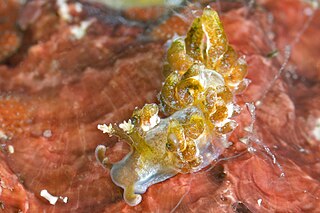
Baeolidia variabilis is a species of sea slug, an aeolid nudibranch. It is a marine gastropod mollusc in the family Aeolidiidae found in the Philippines, the Marshall Islands and Papua New Guinea, central Indo-Pacific Ocean.
Janolus flavoanulatus is a sea slug species. The specific name is derived from Latin words flavus (“yellow”) and anulatus (“ringed”). These soft-bodied mollusks are known for their extraordinary colors and prominent forms. The first description of this species was reported by researcher Terry Gosliner, a leading researcher in the evolutionary history of nudibranchs. Upon his conducted research in the Philippines, Gosliner named Janolus flavoanulatus for its yellow ring around its cerata.














